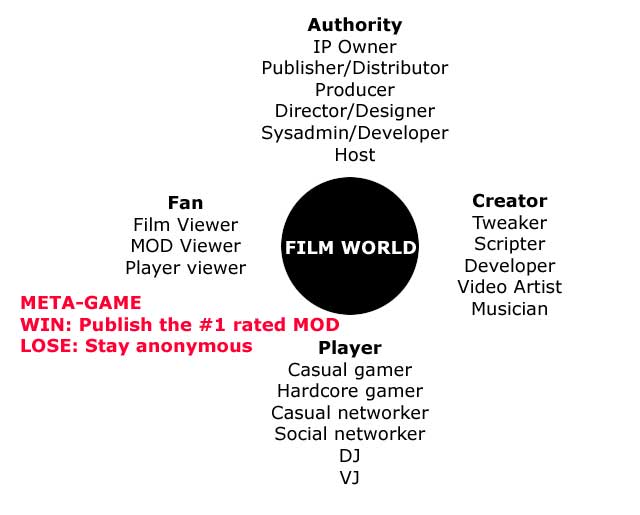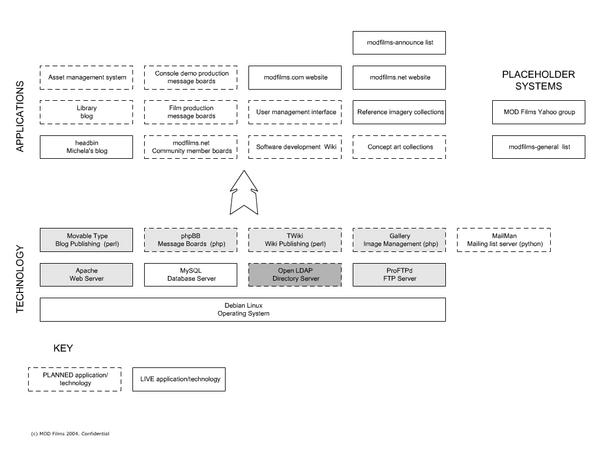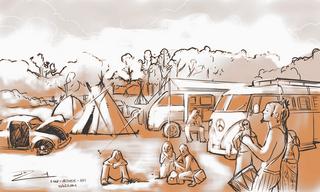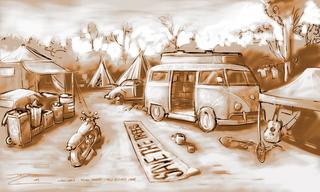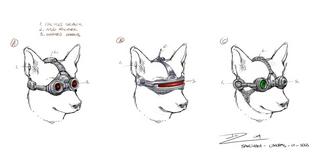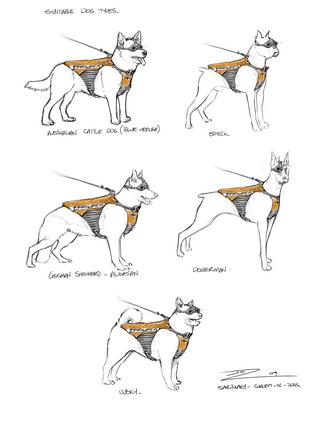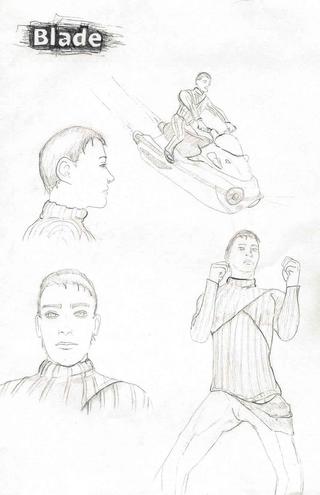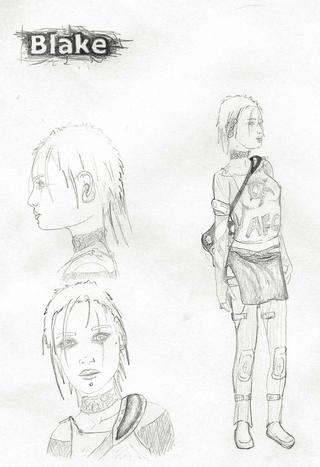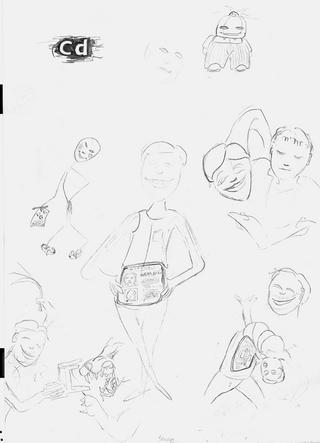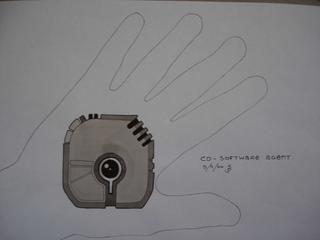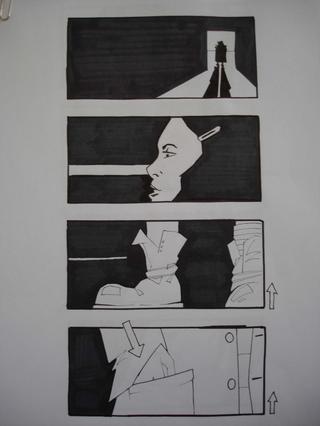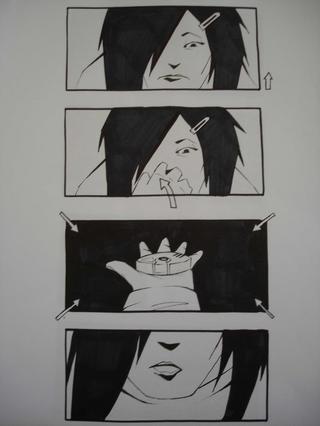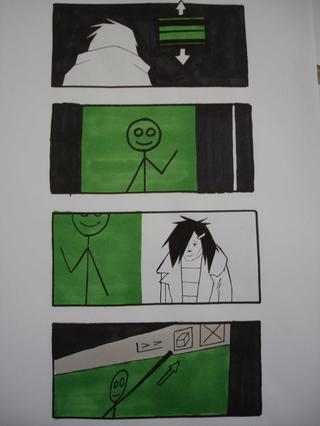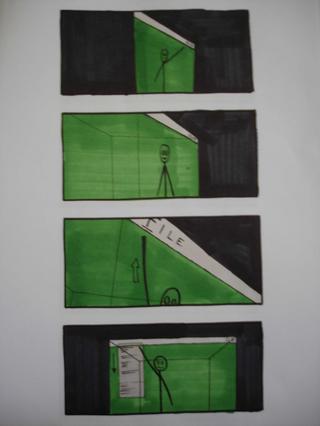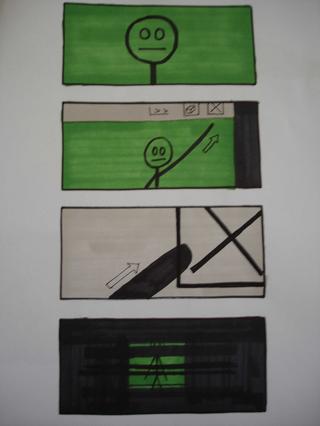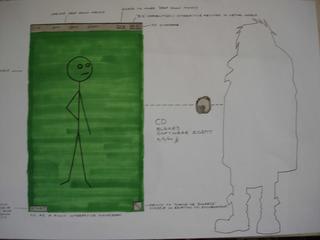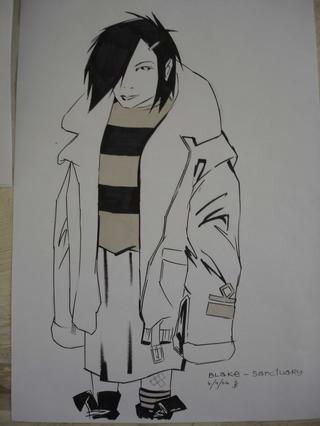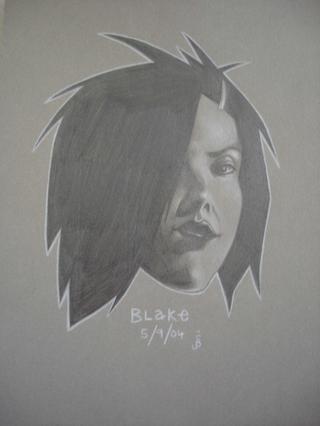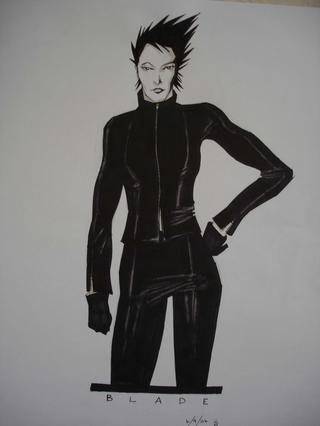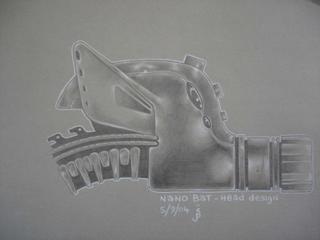September 30, 2004
Team Sanctuary homepage
Thanks to all your feedback, the virtual team has a new home.
http://modfilms.com/teamsanctuary
You are all invited to use the Wiki as a starting point, but if that means goobledigook to you, or comes across as far too intimidating, then simply bookmark this address.
Thanks for bearing with me as we build a logical structure around a new paradigm. It'll be worth it. Promise! {:-)
September 28, 2004
September 27, 2004
Collaborative space update
Some major updates have been made to the collaborative project space over the last week.
1) The Image Gallery system is live for easy management of incoming material.
1) The Discussion Forums are live for alpha testing the community features as well as to support the various departments.
Please use the link below to register your details (use the same as headbin to keep things simple)
http://modfilms.com/forums/profile.php?mode=register
The forums are a more effective way of carrying on a conversation on a topic because you can set an option to receive email updates when anyone responds to what you write. You can also put in IM details if appropriate. The production forums are not visible to you until we've classified you as a team member so jump in and let's get started.
headbin will contain to act as my personal publishing system (I get lots of updates, the rest of you don't) but the team activities have outgrown da blog.
3) The MOD Films Wiki is up and running. If you have no idea or desire to know what a Wiki is than feel free to stop reading now... as long as you want to be part of the development team.
A Wiki is a web site where everyone is allowed to edit any page. This is how the project technical documentation will be maintained going forward.
Use the same login details to access the Wiki. To edit a page, you need to register your details.
We've had a go at drafting a top level view of the project
http://modfilms.com/twiki/bin/view/Sanctuary/
September 26, 2004
Nano bat Heat-Detecting Sensor
Heat-Detecting Sensor May be Able to Detect Lying
By Bijal P. Trivedi
National Geographic Today
January 2, 2002
As if taking off your shoes at the airport and having them electronically sniffed for explosives was not strange enough, future security devices could include heat sensors that would scan crowds for individuals thinking about committing, or having committed, some sort of deceptive act.
http://news.nationalgeographic.com/news/2002/01/0102_020102TVsensor.html
A new sensor has been developed based on the finding that lying or other acts of deception tend to cause excessive blood-flow to the face that can be detected with thermal imaging equipment. According to a new report published in the January 3 issue of the journal Nature, lying triggers a rush of blood around the eyes that can be detected by the heat sensor.
The expectation is that such technology might ultimately be used to pluck out terrorists or other criminals from crowds.
The researchers, led by James Levine, of the Mayo Clinic in Rochester, Minnesota, tested the heat-sensing lie detector by having some test subjects commit a mock crime—in this case stabbing a mannequin and taking its money. The subjects were then asked if they stole U.S. $20.
Levine found that the imaging device correctly pegged 83 percent of the study subjects as either innocent or guilty.
"If after more testing the technology proves accurate it could prove invaluable in high-level security operations, such as airport security, border checkpoints, schools, and federal buildings," said Levine.
Levine began working on the heat-sensing lie detector quite serendipitously.
Levine's research at the Mayo Clinic focuses on how subtle activities alter a person's metabolism. One such activity that piqued his interest was gum-chewing.
A few years ago Levine found that gum-chewing increased metabolism by 20 percent. To determine which muscles where involved in this task he had volunteers chew gum in the dark next to a thermal-imaging camera. One day during these dark gum-chewing sessions a metal plate fell in the room creating a loud crash.
The startling noise caused the panicked gum-chewer's face to glow on the thermal-imaging camera as blood rushed to her face.
This was the "Eureka moment," said Levine. "We wondered whether anxious behavior always caused blood to rush to this area around the eyes and wondered whether a thermal-imaging camera could be used as a lie detector."
The thermal-imaging technology is about as accurate as a polygraph lie detector, which measures pulse, blood pressure, breathing, and sweatiness. But the difference is that only when an expert administers the polygraph is accuracy more than 80 percent, said Levine.
The advantage of the thermal-imaging technology is that it does not require an expert to analyze the results. And it is non-invasive. It can take heat measurements without having to strap a person to a slew of sensors.
However, the imaging technology needs considerably more testing before it could be considered as a tool for security purposes, said Levine.
How eating or running would affect metabolism and the blood-flow to the face is not known, said Levine. The effects of psychological baggage would also need to be assessed. For example, would a person's guilt over a shoplifting incident affect the response if asked whether he or she was carrying a weapon while passing through a security checkpoint?
Levine believes the trick with the thermal imaging sensor is that it can record an instantaneous metabolic response to a question that is unaffected by other past events. Still, this needs to be tested.
The technology could also be easily abused. "Should the police have such a device in their car, for example," said Levine.
On the other hand, it would prove a wonderful new tool for journalists.
September 24, 2004
Activist brief
The activists are based on a notion of Australian forest protection groups
http://thequality.com/flics/10weeks/blog/archives/000613.html#000613
http://thequality.com/flics/10weeks/blog/archives/001203.html#001203
fused with Indymedia, the global activist network. These are the folks who run around the anti-G8 riots webcasting from their backpacks. The network is global but particularly strong in Italy.
Indymedia activist geeks have been instrumental in producling high quality open source software for text, audio and video communication. Classic example of which is Dynebolic (a GNU/Linux based live bootable CD-RW - a multimedia studio out of the box).
No nanobats as yet but they do piss people off...
Secret Service Investigates Indy Media : Idaho Indymedia
Licenses to be finalised
The MOD Films Content license (based on the creative commons license http://creativecommons.org/licenses/by-nc-sa/2.0/legalcode)
and the MOD Films Contributor license (derived from the contributors outline spec http://thequality.com/flics/10weeks/blog/archives/docs/20040915_for_contributors.pdf)
need to be finalised, ideally in time for the contracting of key HoD's.
The contributor license would need to be either:
a non-exclusive license to explore the artwork commercially
OR
a complete assignment of all rights to the artwork (might not be feasible)
September 22, 2004
First re-mixable feature
It's off and rolling... film will never be the same.
Outfoxed - first re-mixable major motion picture
September 21, 2004
Community infrastructure
Discussion on how to clean up user management and integrate various systems coming online shortly.
Hi Lucky,
Thanks for offer to consider our LDAP pickle. I've tried to map out what I'm looking for as to LDAP with the attached JPEG.
Essentially I'd like to migrate a small user database to LDAP and have the technologies marked in light grey authenticate to that instead of what they use currently.
i.e.
Apache - flat file managed by htpasswd
MoveableType - MySQL table
At the moment it'd only for in-house use (a virtual team working on a project described in the PDF) but we need to expand this out to a wider group over time (e.g. beta testers, online community members).
I'm assuming LDAP is the recommended option but happy to hear of any alternative options. This is a fledgling film company, no IT powerhouse, so ideally the setup will be something simple and standard.
X3D for real-time graphics
The web3d crowd are very keen to prove that the latest tools (Vizx3d for authoring and Flux for rendering) are just as good as any game engines out there. I'm sitting on the fence, having lived through the VRML years, but I'd definitely like to explore this. Things have moved on alot in the last few years.
headbin image gallery
Thanks to Lewis for installing the new beaut Gallery system.
http://thequality.com/flics/10weeks/gallery/
We'll be tweaking a bit as we go and ironing out a few probs but you can now comment on individual images as requested. We'll be migrating the existing concept art threads across asap.
Any problems, let me know. We've still got some issues to sort out re. username/password setups but the same login details should work there.
September 20, 2004
Marketing/profile idea
How about strengthening the link between the Massive blog (http://thequality.com/massive/weblog/) and the MOD Films site (http://www.modfilms.com/)?
The Massive blog would act as a very good accessory to the MOD Films site, as a sort of research tool/news resource. It would simply be a matter of rebranding the Massive blog with the MOD Films identity and making it a strong feature of the MOD Films homepage, no?
Concept art - Jeremy Love
Temporary post for comments while the gallery system is being set up.
20040920
images/concept_art/jeremy_love
2)
3)
4)
September 16, 2004
Viral Mods
Wondering if there be a problem with viruses embedded in mods.
Would we need to screen each mod individually for viruses before putting them on the community? How does this relate to the 'virus definitions update' that virus-scanning programs have to do intermittently? Might we actually miss a virus until it had made it onto the community and into the PC's of users?
I don't know much about these tech issues, but thought I should mention it in case.
September 15, 2004
Concept art - Brian Walker
Temporary post for comments while the gallery system is being set up.
Sketches from 2002 on early draft of ten weeks in the head bin
images/concept_art/brian_walker
Blade as male avatar
Blake
CD

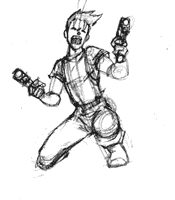
CD cloning Blade's movement
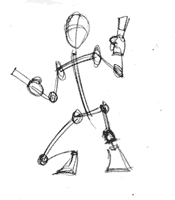
Must check if this Brian's or a drawing we found online - my favourite
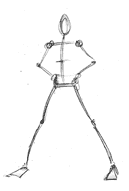
Concept art - Simon Duric
Temporary post for comments while the gallery system is being set up.
20040903
images/concept_art/simon_duric
1)
2)
3)
4)
5)
6)
7)
8)
9)
10)
11)
12)
Concept art - Basil Kinghorn
Temporary post for comments while the gallery system is being set up.
20040907
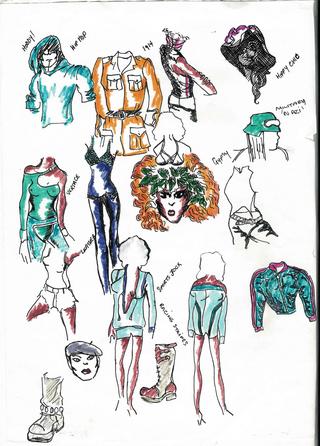 |
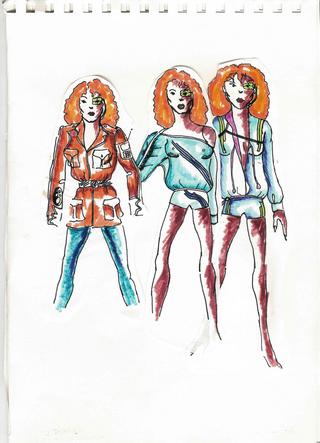
|
September 14, 2004
Concept art update / comic
* We're starting to receive concept art and we're going to get an online image gallery up and running to handle things smoothly. Anyone had any good/bad experiences with Gallery?
* We talking to quite a few concept artists about doing preliminary sketches prior to coming onboard the headbin. Please welcome Baz and Simon who're in first.
* I've been working on my own crude sketches as well to flesh out what I've been thinking of in terms of the overall look and feel and how the story could work in a comic form. I'm not planning on giving up the day job but it's been a helpful exercise. I'm gently prompting by all the prospective producers to clarify how this will look.
I'd like to focus the VFX discussion on the following 18 key panels. At least until we've had a chance to get more concept art in and move onto storyboarding with some of the elements better locked down and better drawn.
My breakdown notes on each panel - exported from Excel so refer to bottom left tags
(read comic zig-zagging down each page)
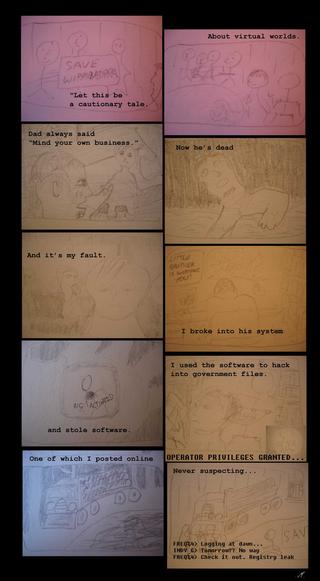
| 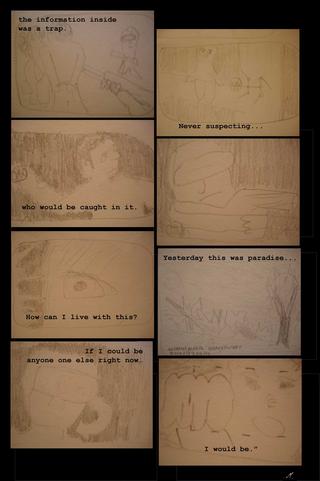
|
September 08, 2004
NESTA Milestone 2 passed
Good news mid-week. NESTA have green lighted the next stage of funding. We hit the second project milestone last week (Interactive Design Document) on schedule.
Here is my report on the last stage. The red (tracked changes in Word) is simply to indicate where things changed from last milestone (it might be easier to read if you Accept them all).
http://thequality.com/flics/10weeks/blog/archives/docs/20040906_nesta.doc
As described in the report, we've tried to slow down the cash-flow to the absolute minimum to give us more time to get the right people onboard and plan properly for the work ahead. Still looking for in particular for developers and designers across the console and community departments.
This is the fun part now, doing the design, and where we can be most flexible. The revised plan is to move into pre-production (with a solid two months of concept visualisation done) by end of October at the latest.
Re-casting the project as a MOD team has already started to pay off in terms of interest and contributions. Special note to Basil Kinghorn (fashion designer) and Simon Duric (illustrator) who've broken the ice on the concept art phase. Simon showed up with ELEVEN sketches for our first meeting this morning. I'm (almost) speechless.
We're working hard to ensure that the line between volunteer and comissioned contributor is clear and that all the work is captured for prosterity. Thanks to Ken for his constant attention to Sanctuary secret HQ and helping me prioritise the issues of the day. Thanks to Archie for taking weight off my shoulders re. our legal wrangling around licensing. Thanks to Christine for guiding us through the State's growing mountain of paperwork. Thanks to Alex for his work on the modfilms.net community design, the blueprint for how we find an audience.
Warm welcome to the newest members of the headbin - Frank Tiddeman, (tech architect), Marcus Gillezeau (film-maker), Ross Howden (film-maker) and Christian Hogue (vfx artist).
Feel free to chat amoungst yourself. Until modfilms.net launches that's what the Yahoo Group is for.
Off we flee to level three!
.M.
September 06, 2004
CASE STUDY: The Corporation
The Corporation - A film by Mark Achbar, Jennifer Abbott, and Joel Bakan has web activism, and film marketing nicely integrated.
September 03, 2004
Initial audio thoughts
Inaugral post on sound. Thanks JohnB for the opportunity to hang out with the game industry's audio folk at Excel for a day yesterday. Good food for the thought.
SUMMARY
Audio was the starting point for this idea (approaching film as musical instrument) and continues to be a large part of what drives me (spot the frustrated muso). Interactive audio design is a large component of what will make it work.
Christian and I have been looking at using real-time techniques as a route to getting the film CG elements in line with concept and budget. After seeing what game audio designers are using, I think we need to start down the same exploration route with audio as well.
Time to get sound people in the mix and thinking about this.
NOTES
Audio remains subordinate to game-play in design terms. No surprise there but it means that speech in games is still problematic even at places like EA (Harry Potting away) because of the way projects are managed. Too many cooks.
One anecdote I heard - when sound designers plump for there being audio-only cues in a game, they normally get knocked back by producers saying "But what is the person is deaf?".
An audio-only virtual set for each location may be the best starting point to designing Groover. Establishing a real-time soundscape for each (using variant samples and semi-random triggering) could be possible as part of the linear film's design process. The impro/pre-viz capabilities of the audio tools in use on games are fab. The sense of having access to the surveillance networks could be seeded in this way.
XBox is _the_ console for sound design. Lots of real-time support, already marketing 'custom soundtrack' capability to the audience. Opportunity for free eval tools (e.g. Sensaura Cage Producer, Microsoft XACT)
Production pipeline for film needs to take real-time audio into consideration. Need more research and consultation with film audio people. A lot of game people doing short films as well so no clear obstacle to converging an approach _but_ need to understand how feature film audio bods think about all this.
What should happen research/planning-wise with sound design in parallel with film pre-production? Need help figuring this out in more detail.
Stress the importance of improvising with actors and early workshops while there is time to get sound design framework in line with what the performances can be. Development on CD as a game character needs to start in film pre-production.
Only quibble with industry advice at forum was on the relevence of impro towards the end of production. The view was that everything should be totally locked down by production and pick-up scripts should be minimal. I don't think this is right for our model. If there's an opportunity to reshape additional audio (i.e. for Groover) at the end of the prototype build stage, I think we do it. Not desirable but I think we need to be open to it needing to happen. They redid 90% of the Fellowship of the Ring dialogue as ADR.
Problems with game voice-overs is partly historical. Voice agents think Commercial Voice Over as the model when Radio Drama is more appropriate.
Casting people need a clear brief as to what we're looking for (re-visit character bios to ensure they work for this). Need to pre-screen wherever possible.
Give kids longer to audition (EA experience). Sight-reading isn't that common.
Test across localisation at an early (Prototype build?) stage. Take this into account in designing flic assets. Make sure the IA supports localisation.
Interesting lead to a software synthesis instrument technology which could be fun for CD and the like. The idea sounds like the old MOD format except that the film embeds an algorithm and sequence data. Need to research that one.
September 02, 2004
dancing to perl in nightclubs
http://www.perl.com/pub/a/2004/08/31/livecode.html
Hyperbolic trees
I'm keen to explore how hyperbolic trees can be used to for asset mapping and visualization on the DVD (in Browser mode) and perhaps contribute to the design of the State aesthetic.
Xreox patented the algorithm in the US which is why most punters have never seen them in use. I've asked Inxight if they'd let us use it for free in the demo.
http://www.inxight.com/products/sdks/st/
The OSS Hypertree project for a non-US audience (where software patenting is yet to take affect). I think this means you could sell Sanctuary in Europe with this but maybe not for long.
http://hypertree.sourceforge.net/
Tamara who helped write the book on this stuff. I've been playing with the H3 viewer she wrote for years.
Tamara Munzner, UBC Home Page
Walrus - US project to map the Net
http://www.caida.org/tools/visualization/walrus/
September 01, 2004
Being a team player
Tips from the folks making real-time feature length movies on how to get the Internet team dynamics going.
Editorial: Being a Team Player on Machinima.com
Oddworld endorse real-time movie-making
Massive: Oddworld Inhabitants talk Stranger
